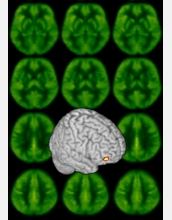All Images
News Release 05-203
Researchers Use Imaging Technique to Visualize Effects of Stress on Human Brain
Method tracks water molecules in blood
This material is available primarily for archival purposes. Telephone numbers or other contact information may be out of date; please see current contact information at media contacts.

The background of this image shows the mean cerebral blood flow of all the volunteers undergoing the stress tasks (mental arithmetic) acquired using the continuous arterial spin labeling (CASL) technique. The foreground shows the detected activation in the right prefrontal cortex--an area long associated with anxiety and depression--when the subjects are under stress.
Credit: University of Pennsylvania School of Medicine
Download the high-resolution JPG version of the image. (86 KB)
Use your mouse to right-click (Mac users may need to Ctrl-click) the link above and choose the option that will save the file or target to your computer.

The continuous arterial spin labeling (CASL) method is very similar to positron emission tomography (PET) scanning but does not require injections or radioactivity. To measure blood flow in the brain, the technique uses a functional magnetic resonance imaging (fMRI) magnet to "tag" water molecules in the patient's blood, which also serves as the natural contrast agent.
Credit: University of Pennsylvania School of Medicine
Download the high-resolution JPG version of the image. (75 KB)
Use your mouse to right-click (Mac users may need to Ctrl-click) the link above and choose the option that will save the file or target to your computer.


